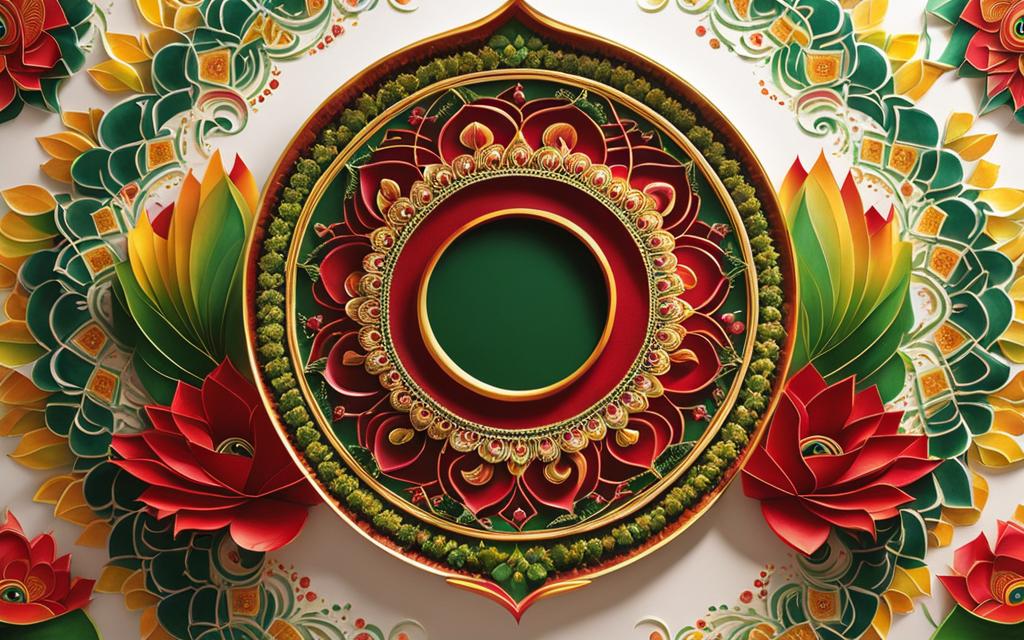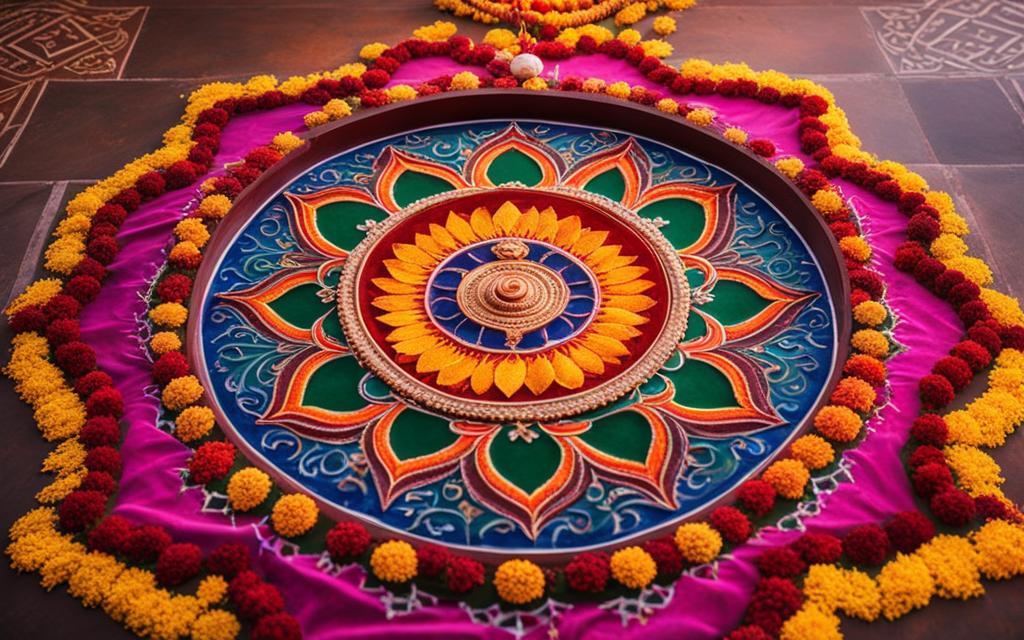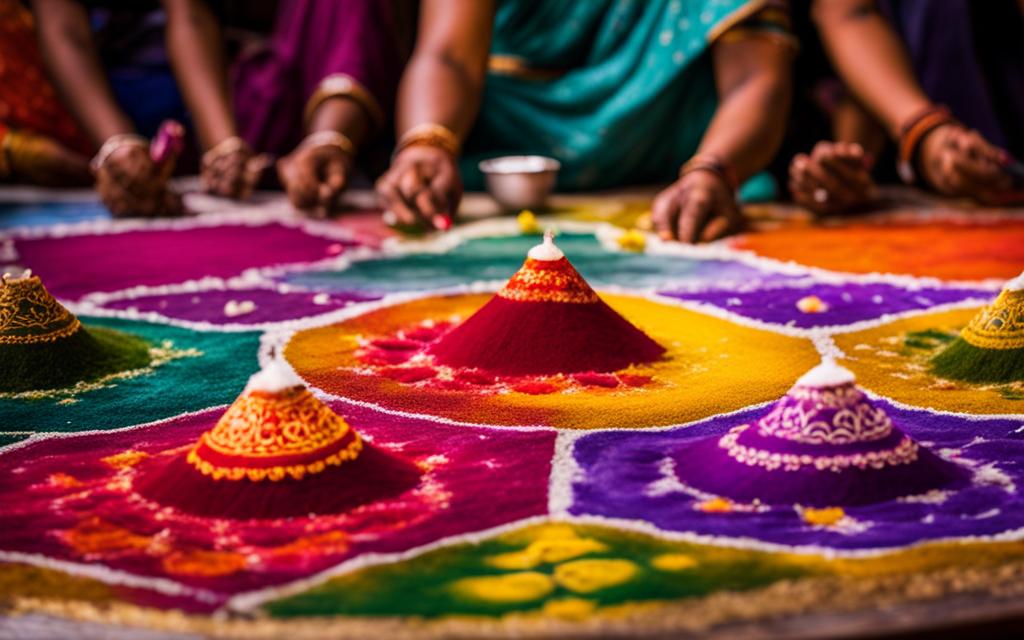Traditional Rangoli Designs: Rangoli, an ancient Indian art form, is a vibrant and captivating way of adorning the floors of homes and public spaces during festive occasions. The term “Rangoli” originates from the Sanskrit words “rang” (colour) and “Cavalli” (row), signifying a decorative pattern made with coloured powders, rice, flowers, or other materials.

Rangoli designs hold deep cultural and religious significance in India and are believed to bring good luck, prosperity, and positive energy to the household.
They have a rich history dating back several centuries and are created using materials such as coloured powders, rice flour, turmeric, vermillion, and natural dyes.
Rangoli designs are an integral part of various Indian festivals and celebrations, such as Diwali, Pongal, Navratri, and Onam. While traditional designs remain popular, contemporary artists have introduced innovative styles to the art form, incorporating new techniques and themes.
If you’re inspired to create your own Rangoli design, there are a few tips you can follow, such as choosing a suitable location, sketching the design lightly, starting with a simple design, experimenting with colour combinations, and applying a fixative to preserve the design.
Table of Contents
The Significance of Rangoli Designs
Rangoli designs hold deep cultural and religious significance in India. The term “Rangoli” originates from the Sanskrit words “rang” (colour) and “Cavalli” (row), signifying a decorative pattern made with coloured powders, rice, flowers, or other materials.
These intricate and vibrant designs are believed to bring good luck, prosperity, and positive energy to the household.
The Cultural and Religious Significance
Rangoli designs are an integral part of various Indian festivals and celebrations, symbolizing the presence of deities and expressing gratitude to nature and other deities.
They are created to welcome and invoke the blessings of the gods and goddesses, inviting them into the home or public space.
The intricate patterns and vibrant colours used in rangoli designs create a positive and festive ambience, fostering a sense of joy, harmony, and togetherness.
Bringing Good Luck and Prosperity
The presence of rangoli designs is believed to ward off negative energies and bring good fortune to the household. It is believed that these designs, made with vibrant colours and auspicious symbols, create a positive energy field, attracting prosperity and abundance.
The intricate patterns and symmetrical designs are thought to bring harmony and balance to the environment, promoting a sense of positivity and well-being.
A Reflection of Cultural Diversity
Rangoli designs showcase the rich cultural diversity of India, with different regions having their distinct styles and motifs.
From the geometric patterns of Kolam in Tamil Nadu to the intricate Alpana designs of West Bengal, each style reflects the unique artistic traditions and cultural influences of the region.
This diversity is celebrated during festivals and occasions, where people from various backgrounds come together to create and admire these beautiful designs.
In summary, rangoli designs hold immense cultural and religious significance in India. They are believed to bring good luck, prosperity, and positive energy to the household and create a festive and harmonious ambience.
These intricate and vibrant designs reflect the cultural diversity of India and serve as a medium to express gratitude, invoke blessings, and celebrate the beauty and traditions of the country.
Historical Background of Rangoli
The rich history of Rangoli dates back several centuries, making it a truly fascinating art form. Initially, Rangoli was created using rice flour as a means to feed ants and birds, symbolizing our harmonious coexistence with nature.
As time went on, it evolved into much more than that – it became a form of artistic expression and a medium for storytelling.
Throughout India, different regions have developed their own unique styles of Rangoli. In West Bengal, it is known as Alpana, in Tamil Nadu as Kolam, and in Rajasthan as Madana.
Each style showcases distinct patterns, motifs, and cultural influences, adding to the diversity and beauty of Rangoli designs.
Artists and enthusiasts have used Rangoli as a way to convey stories and messages. The intricate and vibrant patterns often depict scenes from mythology, folklore, and daily life
. These designs not only serve as decorative elements but also create a sense of joy and wonderment, capturing the essence of Indian culture and tradition.
The Artistic Expression of Rangoli
Rangoli is more than just a decorative floor art – it is a powerful form of artistic expression. The use of vibrant colours, intricate patterns, and meaningful symbols allows artists to convey their emotions and ideas.
Each stroke and curve tells a story, captivating the audience and drawing them into the world of Rangoli.
- Rangoli designs often reflect the artist’s creativity and imagination
- They showcase the artist’s attention to detail and precision
- They allow for experimentation with different colour combinations and materials
- They serve as a medium for cultural preservation and celebration
Whether it’s a traditional design passed down through generations or a contemporary interpretation, Rangoli designs continue to captivate and inspire people around the world.
Through this art form, we can glimpse into the rich history, culture, and artistic heritage of India.

Rangoli: A Fascinating Blend of History and Creativity
Rangoli designs are not just beautiful patterns – they are a reflection of our cultural heritage and a celebration of our artistic spirit.
By exploring the historical background of Rangoli, we gain a deeper appreciation for this captivating art form and the stories it tells.
- Rangoli serves as a reminder of our connection with nature
- It allows us to express our creativity and imagination
- It symbolizes the beauty and diversity of Indian culture
- It brings joy, harmony, and positive energy into our lives
So, the next time you witness a mesmerizing Rangoli design, take a moment to appreciate the rich history and artistic expression behind it.
Let it inspire you to explore your own creativity and embrace the beauty of traditions passed down through generations.
Materials and Techniques Used in Rangoli
Creating a Rangoli design is a delightful and creative process that utilizes a variety of materials and techniques. The vibrant coloured powders, such as rice flour, turmeric, vermillion, and natural dyes, are commonly used in traditional Rangoli designs. These powders bring a burst of colour and add vibrancy to the overall design.
Additionally, flower petals are often incorporated into Rangoli to enhance the visual appeal and create a fragrant ambiance. Coloured sand, chalk, and even acrylic paints are also used in modern variations of Rangoli, allowing for more versatility and creativity.
When creating a Rangoli design, the first step is to draw an outline using chalk or a pencil. This outline serves as a guide for the overall shape and structure of the design. Once the outline is complete, the next step is to fill the design with colours or materials of choice.
Artists often experiment with different colour combinations and techniques to create visually stunning and intricate patterns.
Techniques Used in Rangoli:
- Using vibrant coloured powders, such as rice flour, turmeric, vermillion, and natural dyes
- Incorporating flower petals into the design
- Using coloured sand, chalk, or acrylic paints for modern variations
Steps to Create a Rangoli Design:
- Draw an outline using chalk or a pencil
- Fill the design with colours or materials of choice
Common motifs found in Rangoli designs include intricate patterns, geometric shapes, flowers, and religious symbols.
These motifs add depth and meaning to the design, reflecting the rich cultural heritage of India.
Artists and enthusiasts continuously explore new materials and techniques to push the boundaries of Rangoli art, resulting in unique and captivating designs.

Engaging in the creation of Rangoli designs provides an opportunity to express creativity, celebrate cultural traditions, and bring joy to festive occasions.
The use of vibrant colours, intricate patterns, and a diverse range of materials makes Rangoli a visually captivating art form that embodies the beauty and cultural heritage of India.
Conclusion
In conclusion, traditional Rangoli designs are a captivating reflection of the beauty and cultural heritage of India.
These vibrant and intricate patterns have been a significant part of festive occasions for centuries, bringing joy and harmony to homes and public spaces. Rangoli is not just an art form, but a powerful expression of creativity and celebration.
The positive energy and prosperity associated with Rangoli designs make them even more special. They not only enhance the aesthetic appeal of a space but also create a positive and festive ambience.
Rangoli designs are believed to bring good luck and positive energy, making them an integral part of Indian traditions and rituals.
As an art form, Rangoli allows individuals to unleash their creativity and explore various themes and styles.
Whether you choose to create traditional designs or experiment with contemporary variations, Rangoli offers endless possibilities for self-expression. Its rich history and cultural significance make it a truly unique and cherished art form in India.
So, let the mesmerizing beauty of Rangoli designs bring joy and harmony to your celebrations. Embrace this ancient art form and experience the magic it adds to your festive occasions.
>> You may also like to read:
FAQ
What is the significance of rangoli designs?
Rangoli designs hold deep cultural and religious significance in India. They are believed to bring good luck, prosperity, and positive energy to the household.
Rangoli designs also symbolize the presence of deities and express gratitude to nature and other deities. They create a positive and festive ambience and reflect the cultural diversity of India.
What is the historical background of rangoli?
Rangoli has a rich history dating back several centuries. Initially, it was created using rice flour as a way to feed ants and birds, symbolizing a harmonious coexistence with nature. Over time, it evolved into a form of artistic expression and storytelling.
Various regions in India have their distinct styles of Rangoli, showcasing unique patterns, motifs, and cultural influences.
What materials and techniques are used in rangoli?
Traditional rangoli designs are made using vibrant coloured powders, rice flour, turmeric, vermillion, and natural dyes. However, modern variations include the use of flower petals, coloured sand, chalk, and even acrylic paints.
The process involves drawing an outline using chalk or a pencil and filling the design with colours or materials of choice. Intricate patterns, geometric shapes, flowers, and religious symbols are common motifs found in rangoli designs.
What is the significance of creating rangoli designs?
Rangoli designs exemplify the beauty, creativity, and cultural heritage of India. These intricate and colourful patterns not only add aesthetic value to homes and public spaces but also serve as a means of self-expression and celebration. They bring joy and harmony to celebrations and fill life with positive energy and prosperity.
